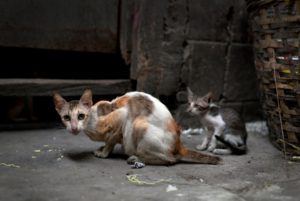
Labelling cats as pests can be difficult for a lot of us, more so for cat lovers. Some would go as far as calling the notion absurd: but is it? Because they are cute and cuddly, people just assume that cats are nice animals to have around while in reality, they can cause just as much trouble as other pests when they intrude on your property.
The biggest problem associated with cats is pooping; cats will literally turn your yard into their litter box. They’ll dig around your lawn and garden creating a huge mess that you’ll have to clean up. And if you keep pets of your own, intruding cats will agitate them making them hard to control.
Furthermore, feral cats could also introduce other pests such as fleas and ticks to your home. These pests will be distressing to both you and your pet.
What is a cat’s life cycle?
After fertilisation, a female cat will go through a gestation period that lasts 64 – 67 days before it gives birth. Being multiparous, cats will produce more than one offspring in one birth (known as a litter). A litter will produce 3 – 5 kittens.
A cat’s first litter produces the largest number of offsprings, a number that will decrease with subsequent births. A female cat can produce up to 3 litters per year, meaning that it could produce up to 150 kittens over its fertile span of 10 years.
After producing the offsprings, a female cat will take care of her young for 1 year before they can survive on their own.
Female cats reach sexual maturity in 10 months with their male counterparts doing so in just 7 months. A cat can live for up to 15 years depending on the breed.
(Source: https://en.wikipedia.org/wiki/Cat)
View our cat control products >
How do you control cat pests?
Preventing a cat intrusion is the cheapest and easiest way of controlling pest cats. You can prevent cats from invading your property by:
- Eliminating food and water sources. Keep your property free of food and water sources that could attract feral cats. Ensure your rubbish and wheelie bins are securely covered to deny any straying animals access to food. Fix leaky outdoor pipes and taps as water too could attract unwanted animal visitors. Ensure you also clean up after barbecues and eat outs to get rid of all remaining food crumbs.
- Notify the owner of the cat. Sometimes the intruding cat could be your neighbour’s pet. If you know the owner, alert them of their pet’s intrusion so that they can take measures to ensure that it does not happen again.
- Use cat deterrents. Cat deterrents such as wall spikes and animal repellers can also be used to ensure that stray cats do not set foot on your property.
Using traps for cat pest control
If feral cats are still a nuisance after taking the above measures, you can trap them and either relocate them or hand them over to a veterinary for humane euthanization. If you decide to use the trapping method, use a suitable bait to attract the cats to the trap. Some of the bait options you could use include:
- Catnip
- Wool or cotton
- Soiled cat litter or cat urine.
- Meat (could be beef, cat food, fish, chicken or any other kind of meat.)
Follow these steps to successfully trap feral cats:
- Read and follow the instructions provided with the trap to install the trap in the trouble area. Your pets, if you have any, should be kept indoors when the trap is set up
- Place the bait inside the trap with additional lures around.
- Check regularly to see if you have captured any stray cats.
- If you catch one, ensure it’s feral by checking whether it has a collar.
- If not, take the cat to a veterinarian who’ll scan the cat for a microchip to further determine whether it’s feral. If it is, the vet will euthanize the cat humanely.
Ensure to take safety precautions such as wearing industrial grade gloves and using a catching pole when transferring the animal.
View our cat control products >
 займ под квартирузайм по номеру телефоназайм без предоплат и комиссий
займ под квартирузайм по номеру телефоназайм без предоплат и комиссий



